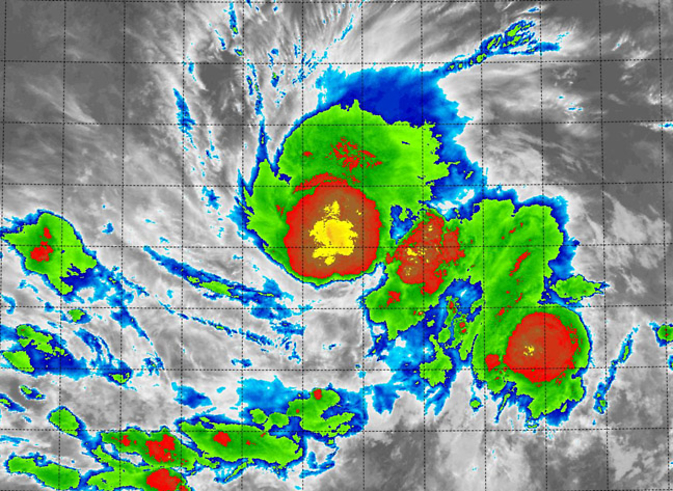Tropical Storm Vance's Center Looks Like a Pumpkin to NASA's Terra Satellite

NASA's Terra satellite passed over Vance on October 31 at 12:55 a.m. EDT and saw thunderstorms around the center resembling a pumpkin with a stem in false-colored infrared imagery. Image Credit: NASA/NRL
Tropical Depression 21E formed on Oct. 30 after struggling for days as a low pressure area. Just a day later it strengthened into a tropical storm and was renamed Vance.
NASA's Terra satellite passed over Vance on October 31 at 4:55 UTC (12:55 a.m. EDT) – the witching hour – and the Moderate Resolution Imaging Spectroradiometer or MODIS instrument aboard Terra captured infrared data.
That infrared data was false-colored when the image was created. High, strong thunderstorms with cold cloud top temperatures that circled the center were false-colored in an orange-red color, and resembled the shape of a pumpkin with a stem!
At 5 a.m. EDT, Tropical Storm Vance's maximum sustained winds were near 45 mph (75 kph) and is expected to strengthen gradually. Vance was centered near latitude 10.5 north and longitude 101.0 west.
That's about 450 miles (720 km) south of Acapulco, Mexico. Vance is moving toward the west-southwest near 3 mph (6 kph) and is forecast to turn to the west and west-northwest on Nov. 1.
National Hurricane Center Forecaster Dan Brown noted that Vance's center was near the southern edge of the large mass of deep convection due to moderate south-southwesterly shear.
The shear and some dry low- to mid-level air are expected to continue to affect the tropical cyclone during the next 12 to 24 hours, and only gradual strengthening is expected during that time.
Most of the intensity guidance shows Vance becoming a hurricane in 2 to 3 days.
Rob Gutro
NASA's Goddard Space Flight Center
Media Contact
All latest news from the category: Earth Sciences
Earth Sciences (also referred to as Geosciences), which deals with basic issues surrounding our planet, plays a vital role in the area of energy and raw materials supply.
Earth Sciences comprises subjects such as geology, geography, geological informatics, paleontology, mineralogy, petrography, crystallography, geophysics, geodesy, glaciology, cartography, photogrammetry, meteorology and seismology, early-warning systems, earthquake research and polar research.
Newest articles

Webb captures top of iconic horsehead nebula in unprecedented detail
NASA’s James Webb Space Telescope has captured the sharpest infrared images to date of a zoomed-in portion of one of the most distinctive objects in our skies, the Horsehead Nebula….

Cost-effective, high-capacity, and cyclable lithium-ion battery cathodes
Charge-recharge cycling of lithium-superrich iron oxide, a cost-effective and high-capacity cathode for new-generation lithium-ion batteries, can be greatly improved by doping with readily available mineral elements. The energy capacity and…

Novel genetic plant regeneration approach
…without the application of phytohormones. Researchers develop a novel plant regeneration approach by modulating the expression of genes that control plant cell differentiation. For ages now, plants have been the…





















